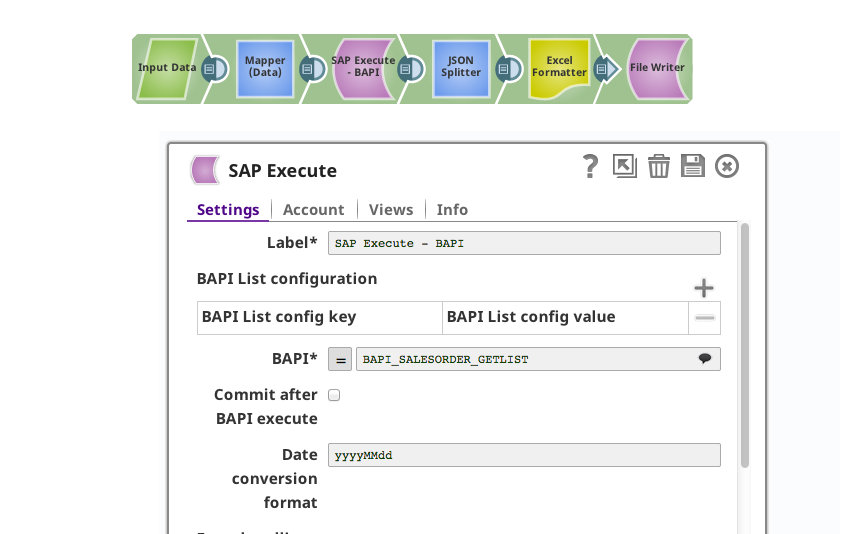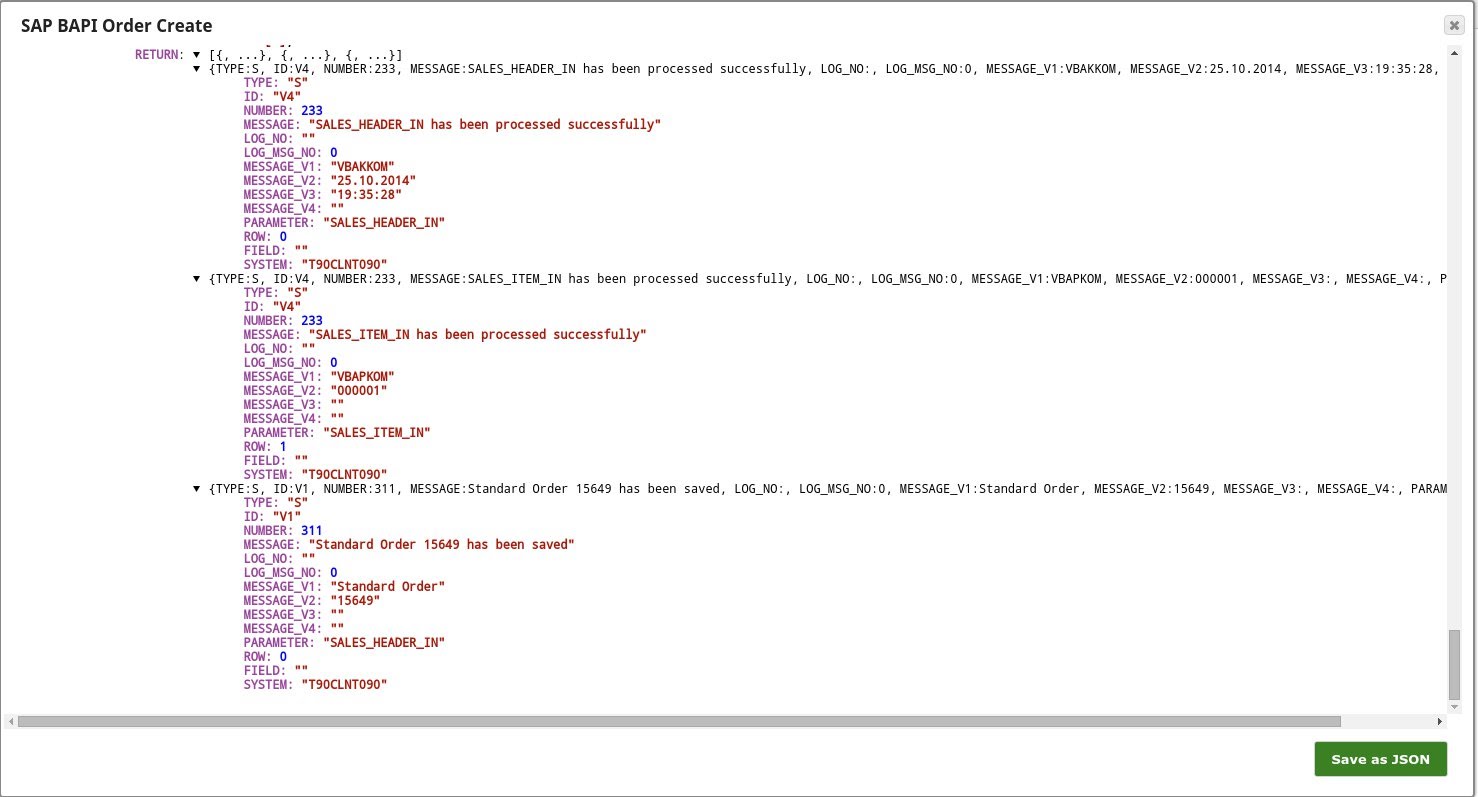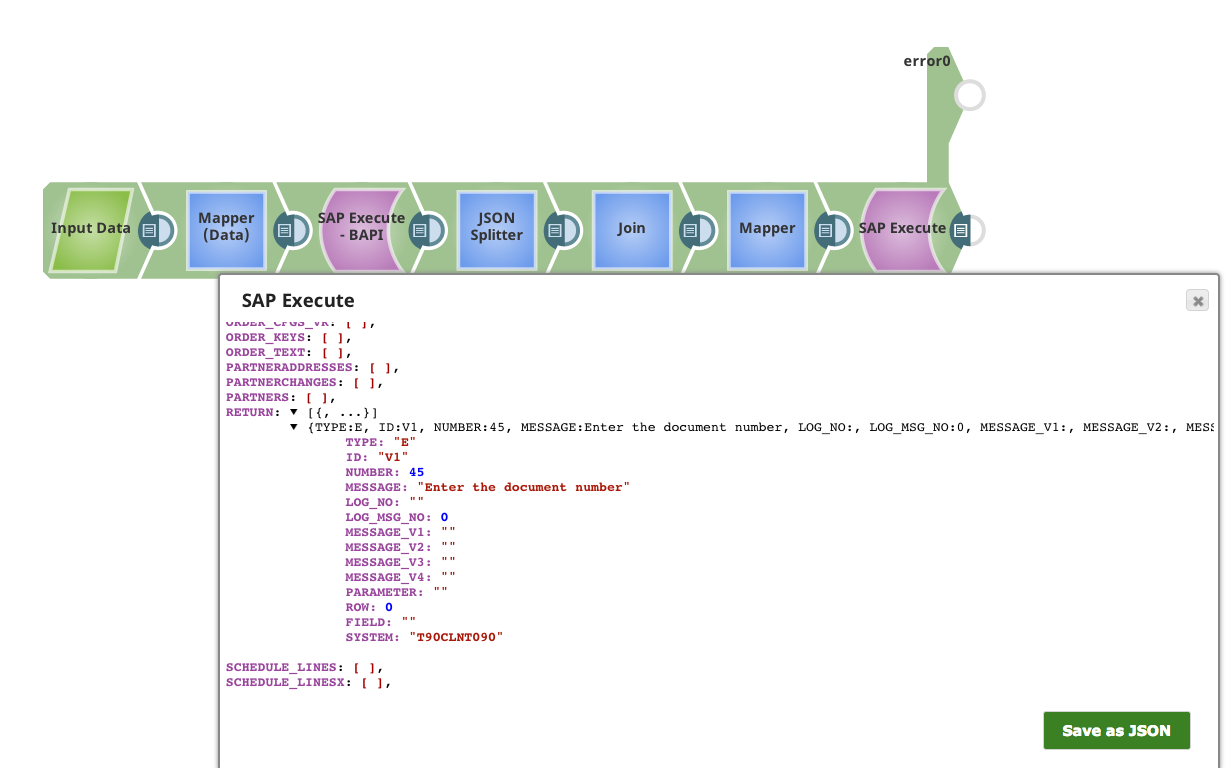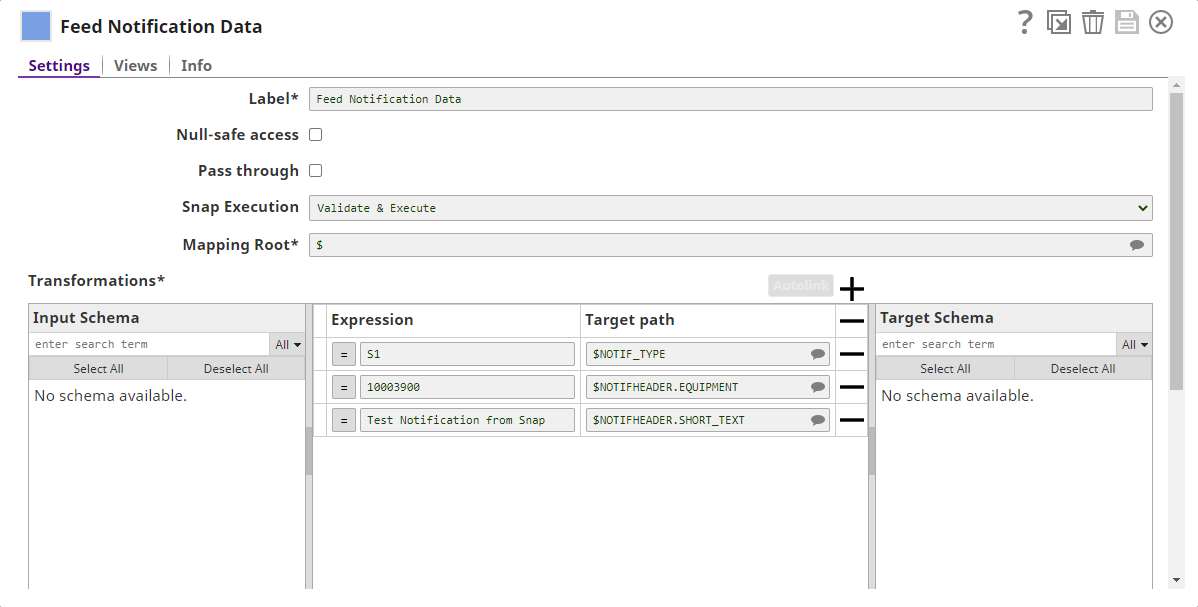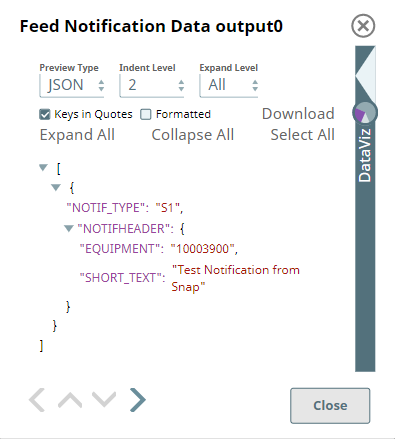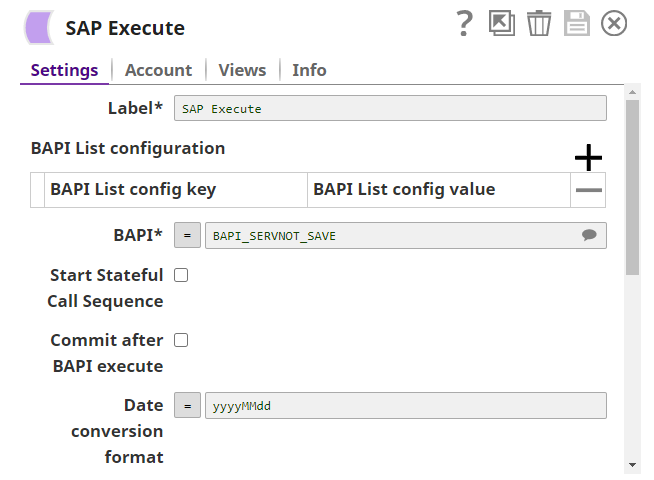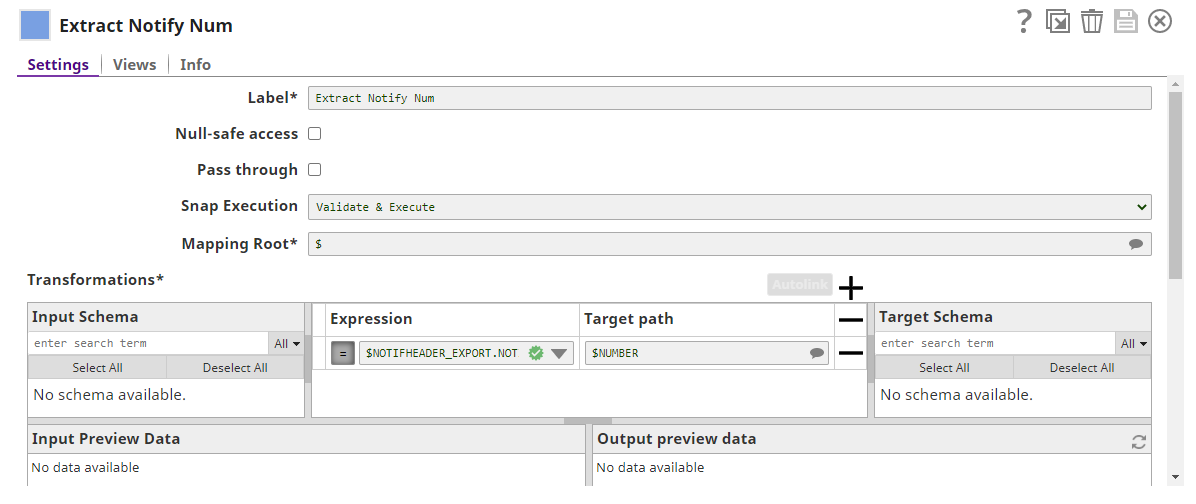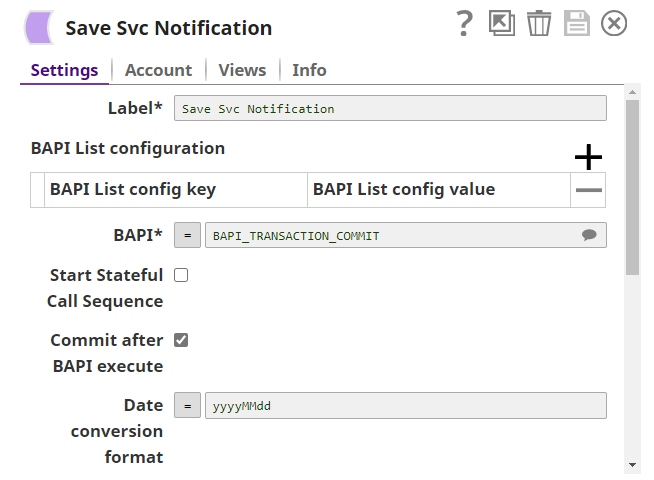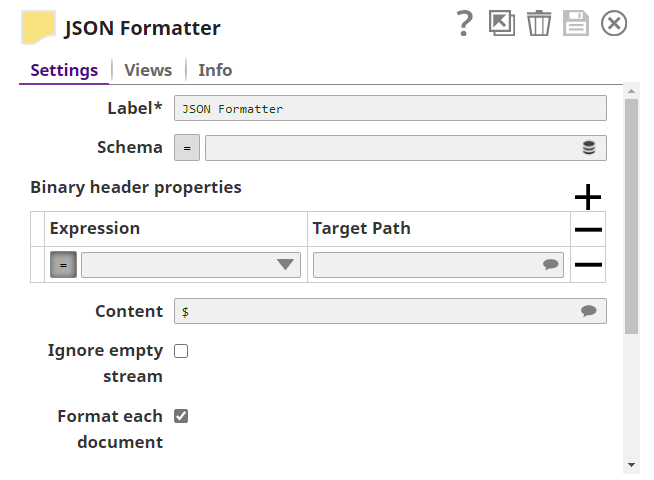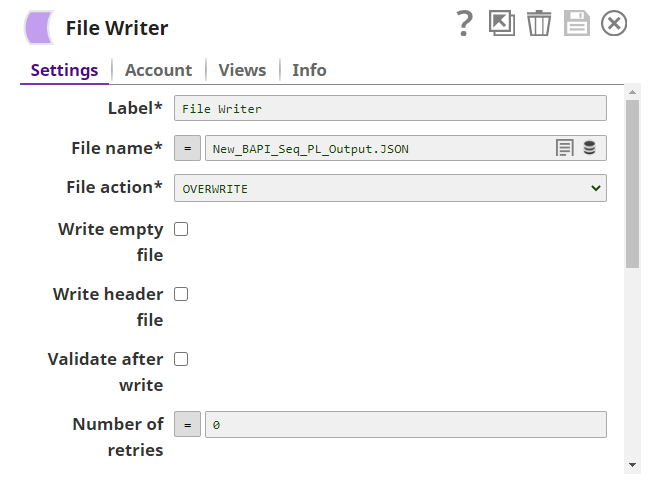On this Page
| Snap type: | Write | ||||||
|---|---|---|---|---|---|---|---|
| Description: | This Snap executes the configured SAP business API (BAPI) given input data, if any, and returns an output document that contains the results of the execution. The BAPI input schema and output schema are provided to correctly map data into the SAP BAPI. Expected upstream Snaps: Field can be mapped using an upstream Mapper Snap, which will allow the mapping of fields or values to the field that are available on the selected service object. Expected downstream Snaps: The Snap will output one document for every BAPI execution, hence any document processing Snap can be used down stream. Expected input: Document that conforms to the input view schema of the Snap. The input view schema is provided to an upstream Mapper Snap based on the selected service object. Expected output: Document which represents the record structure of the retrieved BAPI output definition. Each record is represented as one document on the output view. SAP BAPIs do not enforce standard error messaging, so error views of Snaps that immediately follow the SAP Execute Snap should be set to discard the error data and continue. Otherwise, your pipeline will not run. SAP BAPIs for IntegrationBAPI technology in SAP is based on import and export parameters that determine what must be provided (import) and what will be returned (export). BAPI's can be tested in the SAP client via transaction code SE37. Import parameters contain data to be transferred from SnapLogic to the BAPI. Specific values must be provided as import parameters in order for the BAPI to execute and return the desired data.This is the data stream which will be provided in the input view of the SAP Execute Snap. Export parameters contain data to be transferred from the BAPI back to SnapLogic, which is returned back in the output view of the SAP Execute Snap. The data returned back can be of the following types:
The list of BAPI's in a particular SAP client will vary depending on the level of customization, however an exhaustive set is delivered as standardized BAPI's which provide basic functions and can be used to read and write or change data for most SAP Business Objects. BAPIs for Reading DataThe following BAPIs provide you with read-only access to data in the associated business object:
BAPIs for Creating or Changing DataThe following BAPIs can create, change or delete instances of a business object:
| ||||||
| Prerequisites: | Have the SAP BASIS administrator setup the user to be used in the appropriate SAP clients with certain set of authorizations. To execute a BAPI as part of your application program, the users of your application must have the appropriate authorizations set up in their respective master records. The documentation provided with the BAPI contains information about the required authorizations. Any attempts to execute a BAPI that fail as a result of insufficient authorization are reported back to the calling application. | ||||||
| Support and limitations: | Works in Ultra Task Pipelines. | ||||||
| Account: | This Snap uses account references created on the Accounts page of SnapLogic Manager to handle access to this endpoint. See Configuring SAP Accounts for information on setting up this type of account. | ||||||
| Views: |
| ||||||
Settings | |||||||
Label* | Specify the name for the Snap. You can modify this to be more specific, especially if you have more than one of the same Snap in your Pipeline. | ||||||
BAPI List configuration | Use this field set to configure the list of BAPIs to return. | ||||||
BAPI List config key | Specify a key to configure the BAPI list that is being returned. | ||||||
BAPI List config value | Define a value to configure the BAPI list that is being returned. See object types at http://wiki.scn.sap.com/wiki/display/ABAP/List+of+BAPI's | ||||||
BAPI* | Specify the business application interface (BAPI) on the SAP server to be executed. This is the ABAP name. The full list of all BAPI's can be viewed by clicking the suggest values icon. Default value: [None | ||||||
| Start stateful call sequence | Use this check box to create a stateful session for calling one (or more) BAPIs using this Snap (and other downstream Snaps). Make sure to select this check box for the Snap where you define your first BAPI call in the Pipeline. Do not select the Commit after BAPI execute check box for this Snap, to extend the stateful session and call more BAPIs using this Pipeline (downstream to this Snap). 'Sequence' implies that the output from a BAPI call is needed for the next BAPI call to run. Default value: Not selected | ||||||
Commit after BAPI execute | Use this check box in any downstream Snap to mark the end of the stateful session, started upstream of this Snap using Start stateful call sequence check box, and commit when no exception is raised; otherwise, the BAPI controls the commits. Make sure to select this check box for the Snap where you define your last BAPI call in the Pipeline. Do not select the Start stateful call sequence check box for this Snap. Do not select both Start stateful call sequence and Commit after BAPI execute check boxes for all other BAPI calls between the first and the last calls in the sequence. For example, Second BAPI call in a 3-call sequence; Second, Third, and Fourth BAPI calls in a 5-call sequence. Default value: Not selected | ||||||
Date conversion format | Format to convert string input values into SAP date/datetime fields. The format string using the same syntax as the Java SimpleDateFormat class. If blank, then no conversion will be performed and an error will be generated by SAP client when an input view string is mapped to SAP date/datetime field. Example: yyyyMMdd Default value: yyyyMMdd | ||||||
| Output DateTime as Text | Select to output date and time as a String data type instead of a DateTime object. Default value: Not selected | ||||||
| Error handling | This property lets you define the error handling. If any error paths and their error values match a corresponding value in the output document, then the document is routed to the error view (if enabled), or the Snap fails (if error view is disabled).
Any newly created SAP Execute Snaps will add the default value above to provide a default for error handling. The Snap will not by default fail/route anything to the error view if the RETURN[*].TYPE value is 'E' in case the error handling is undefined | ||||||
| Max request attempts* | The maximum number of SAP connection attempts in case of a failure. When 0 is entered, the Snap tries for infinite times for the connection. Default value: 3 | ||||||
| Request retry interval | The time in seconds to wait before retrying the request. Default value: 5 | ||||||
| Route errors | Writes configuration errors to the error view. If the error is non-recoverable, especially connection errors such as exception handling would be routed to the error view with relevant information. Default value: Not selected | ||||||
| Reload Function Metadata | Select this checkbox to reload the metadata (latest schema) for the current BAPI function before executing the BAPI function. Loading of metadata may take a while depending on the network speed. | ||||||
Snap execution | Select one of the three modes in which the Snap executes. Available options are:
| ||||||
Examples
The following examples include: one to retrieve data successfully, one to insert data successfully in SAP using the applicable BAPI, one to show an error.
Downloads
See Also
- http://help.sap.com/saphelp_46c/helpdata/en/a5/3ec8464ac011d1894e0000e829fbbd/content.htm for a description of BAPI.

